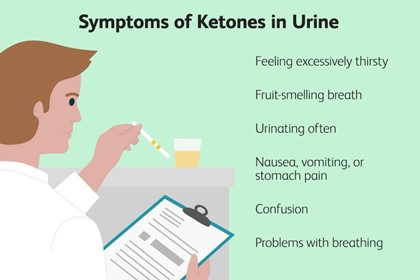A nurse in a pediatric clinic is reviewing the urine laboratory results for an adolescent.
For which of the following results should the nurse notify the provider?
Specific gravity 1.020
Uric acid 475 mg/24 hr
Ketones positive
Nitrites negative
The Correct Answer is C
c. Ketones positive.
Explanation:
Ketones in the urine can be an indication of diabetic ketoacidosis (DKA) or other metabolic disorders. It is abnormal and should be reported to the healthcare provider for further evaluation and management. Positive ketones suggest that the body is breaking down fats for energy instead of using glucose, which can be a sign of inadequate insulin levels or utilization.
Options a, b, and d are within normal ranges or do not indicate an immediate concern. A specific gravity of 1.020 is within the normal range and indicates appropriate urine concentration. Uric acid levels of 475 mg/24 hr are not mentioned as abnormal or concerning in the context provided. Nitrites negative indicates the absence of nitrites in the urine, which is a normal finding and indicates the absence of a urinary tract infection.
However, it's important to note that clinical judgment should always be exercised, and the nurse should consider the patient's overall clinical presentation and history when interpreting laboratory results and making decisions regarding reporting to the provider.

Nursing Test Bank
Naxlex Comprehensive Predictor Exams
Related Questions
Correct Answer is D
Explanation
Grapes are a common choking hazard for young children, especially toddlers, due to their small size, round shape, and slippery texture. The size and shape of grapes can block the airway and pose a significant risk if not properly cut or prepared before being given to a toddler. It is recommended to cut grapes into small pieces or slice them lengthwise to reduce the risk of choking.
While potatoes, corn, and oranges can also pose a choking risk if not properly prepared or cut into age-appropriate sizes, they are not as commonly associated with choking incidents in toddlers as grapes are. Nonetheless, it is essential for parents and caregivers to be aware of appropriate food preparation techniques and supervise children during meals to ensure their safety.
Correct Answer is A
Explanation
Answer: A
Rationale:
A) Serve meals with plastic utensils: Serving meals with plastic utensils is essential to reduce the risk of self-harm. Metal utensils could be used by the client to inflict injury upon themselves, so providing plastic utensils is a necessary safety measure to prevent potential harm.
B) Assign another client to accompany the client to therapy sessions: Assigning another client to accompany the client to therapy sessions is not appropriate as it places an undue burden on another client and may not ensure the safety of the at-risk client. Professional staff should provide supervision and support.
C) Assign the client to a private room: Assigning the client to a private room might increase the risk of self-harm due to reduced supervision. It is generally better to place the client in a more observable setting where staff can frequently monitor their condition.
D) Check on the client every 4 hr: Checking on the client every 4 hours is insufficient for someone who has recently attempted suicide. More frequent monitoring, such as constant or every 15-minute checks, is necessary to ensure the client's safety and provide immediate intervention if needed.
Whether you are a student looking to ace your exams or a practicing nurse seeking to enhance your expertise , our nursing education contents will empower you with the confidence and competence to make a difference in the lives of patients and become a respected leader in the healthcare field.
Visit Naxlex, invest in your future and unlock endless possibilities with our unparalleled nursing education contents today
Report Wrong Answer on the Current Question
Do you disagree with the answer? If yes, what is your expected answer? Explain.
Kindly be descriptive with the issue you are facing.
